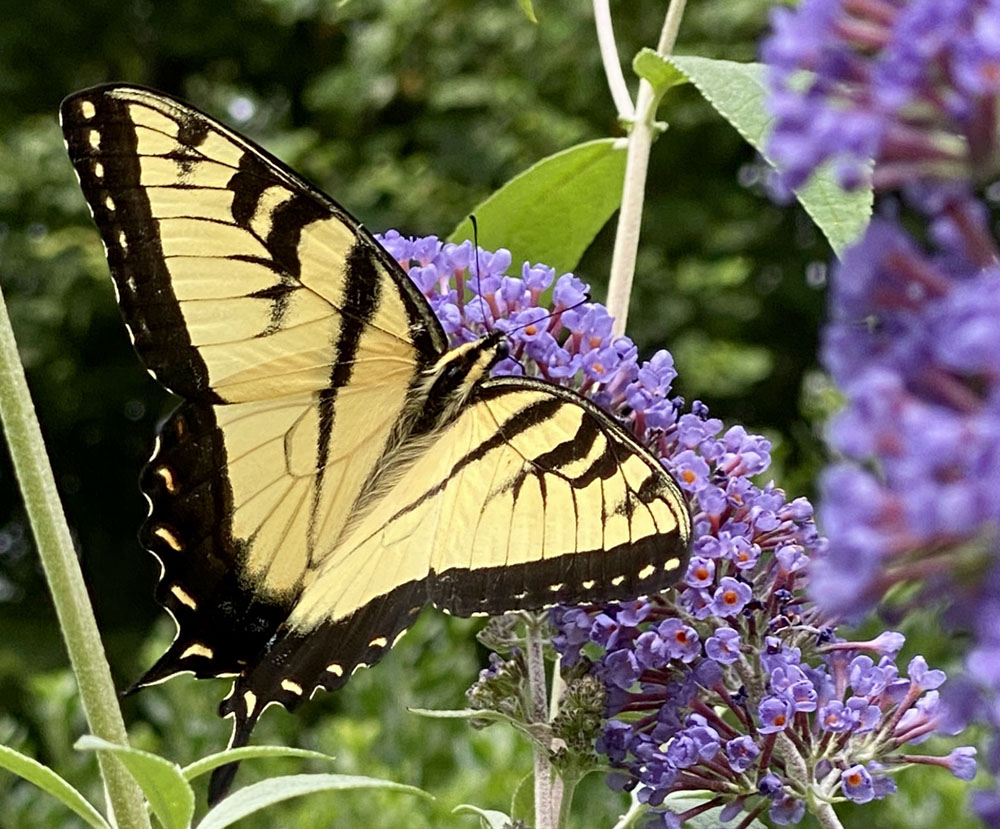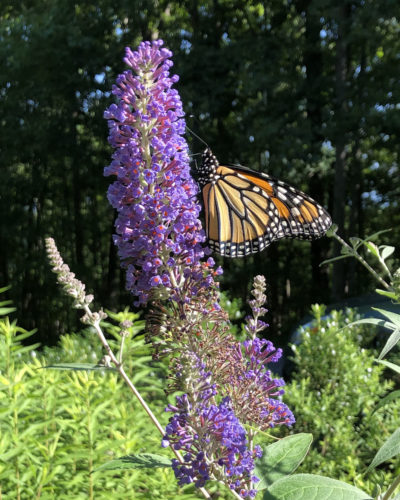 My favorite plant for the butterfly garden is butterfly bush (Buddleia davidii). Butterflies flock to it. Its lavish blossoms grace the summer and fall border with fragrance more intoxicating than any French perfume. Butterflies linger on buddleia, giving you a chance to observe them. The blossoms are also beautiful in flower arrangements.
Unfortunately there is one big drawback to buddleia: It is a non-native invasive species. That means it has the potential to escape your garden and invade large areas, choke out native species and overrun the landscape. This is why I take the designation of invasive species seriously, and you should too. You do not want to contribute to the problem.
My favorite plant for the butterfly garden is butterfly bush (Buddleia davidii). Butterflies flock to it. Its lavish blossoms grace the summer and fall border with fragrance more intoxicating than any French perfume. Butterflies linger on buddleia, giving you a chance to observe them. The blossoms are also beautiful in flower arrangements.
Unfortunately there is one big drawback to buddleia: It is a non-native invasive species. That means it has the potential to escape your garden and invade large areas, choke out native species and overrun the landscape. This is why I take the designation of invasive species seriously, and you should too. You do not want to contribute to the problem.
 To prevent buddleia from spreading into the wild, I gladly and meticulously deadhead every faded buddleia blossom and dispose of it in the garbage. I don’t toss spent blossoms out into the woods or throw them onto the compost pile. Bagging the faded flowers and putting them in the garbage is not an onerous task because buddleia must be deadheaded anyway in order to keep the plant blooming. If you are a devoted gardener, as I am, you may feel the extra step of disposing of the spent flowers properly is worth the delight of growing this glorious plant. BUT if you are not willing to bag the faded flowers and put them in the garbage—and in your heart you know if you are—then don’t plant this shrub. Pass on to the many other flowers that attract butterflies.
If you do decide to grow buddleia, plant only one or two so their extra care is not burdensome. Also, place the plant at the edge of the border so that it is easy to reach the blossoms to deadhead them. A shrub that grows between four to seven feet high is ideal because you don’t have to bend down to deadhead the flowers and, at this height, it is easy to inhale their fabulous fragrance. Because an extra maintenance step is involved, I don’t recommend buddleia for a commercial planting, only for a home garden where an enthusiastic gardener is willing to care for it properly. And when you sell your house, dig up the buddleia before you go. Take it with you or dispose of it.
You might also investigate sterile species of buddleia.
To prevent buddleia from spreading into the wild, I gladly and meticulously deadhead every faded buddleia blossom and dispose of it in the garbage. I don’t toss spent blossoms out into the woods or throw them onto the compost pile. Bagging the faded flowers and putting them in the garbage is not an onerous task because buddleia must be deadheaded anyway in order to keep the plant blooming. If you are a devoted gardener, as I am, you may feel the extra step of disposing of the spent flowers properly is worth the delight of growing this glorious plant. BUT if you are not willing to bag the faded flowers and put them in the garbage—and in your heart you know if you are—then don’t plant this shrub. Pass on to the many other flowers that attract butterflies.
If you do decide to grow buddleia, plant only one or two so their extra care is not burdensome. Also, place the plant at the edge of the border so that it is easy to reach the blossoms to deadhead them. A shrub that grows between four to seven feet high is ideal because you don’t have to bend down to deadhead the flowers and, at this height, it is easy to inhale their fabulous fragrance. Because an extra maintenance step is involved, I don’t recommend buddleia for a commercial planting, only for a home garden where an enthusiastic gardener is willing to care for it properly. And when you sell your house, dig up the buddleia before you go. Take it with you or dispose of it.
You might also investigate sterile species of buddleia.
Text and photography Mary Walton Upchurch © 2020 Author and gardening enthusiast Mary Walton Upchurch grew up in Montgomery, Alabama, and earned a degree in landscape architecture from the Harvard Graduate School of Design. For more than 30 years, she practiced in Montgomery as an award-winning landscape architect and wrote garden articles for a local publication. Today, she lives in western North Carolina, where she built a home and garden on top of a mountain with panoramic views of the Blue Ridge Mountains.



